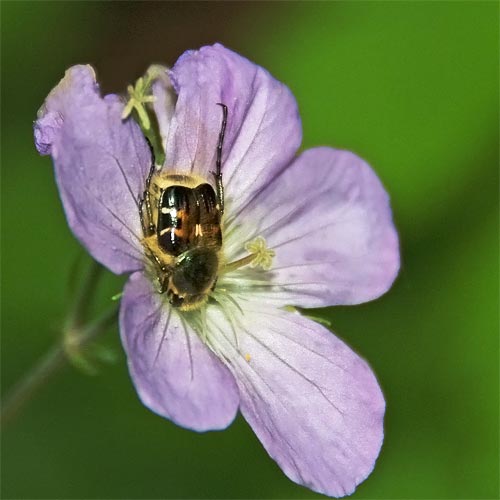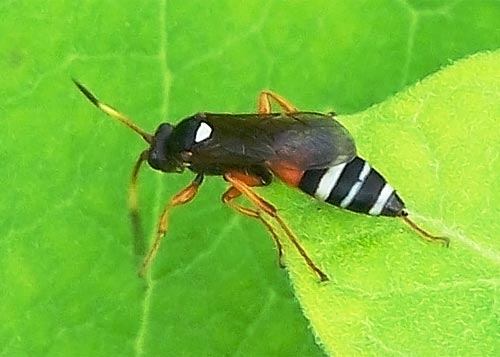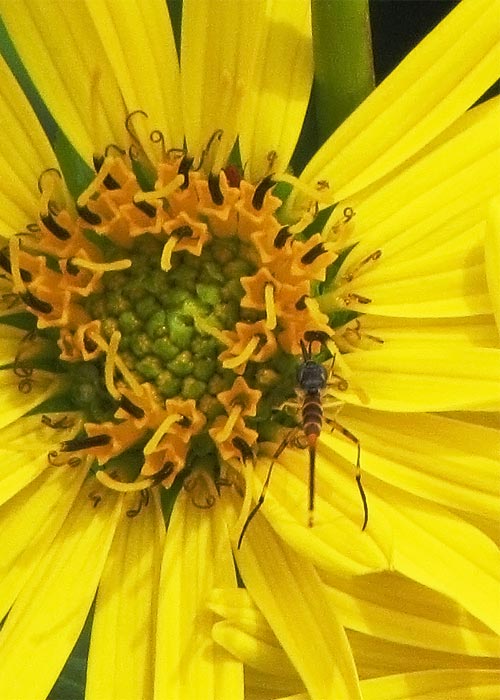Greetings, BugFans,
The BugLady had a professor years (decades) ago who used to say “Don’t just tell them what it is, tell them ‘What about it?’” Here is the second installment of miscellaneous bugs with brief biographies—insects about whom the BugLady can’t find many “What about it’s.”
Flower Scarab
A beetle with a bunch of names—Flower scarab, Hairy Flower scarab/beetle/chafer, Bee-Like Flower Scarab. It’s a scarab beetle in the small (8 species) genus Trichiotinus, and the BugLady thinks it’s probably T. piger. Trichos means hairy in Greek, and piger means lazy. Bonus points to any BugFan who can figure out from the photo why this beetle wasn’t moving very fast.
This chunky, hirsute, diurnal beetle (SAT vocabulary review) lives east of the Great Plains. Like the Japanese beetle (also a scarab), its elytra (wing covers) are shorter than its abdomen, which makes it look like its slip is showing. Its flight is said to mimic bees, and its bumblebee-ish appearance on a flower protects it from some predators.
Adults feed on leaves and on the nectar and pollen of flowers and trees, which they simultaneously pollinate. According to some references, their larvae (grubs) eat plant roots, moving from plant to plant underground until they are ready to pupate (which could take several years), and they can be pests on grains and nursery stock. Other sources say that the grubs feed on/live in decaying wood (which would explain the habitat choice of their elders, in grasslands near woodlands).
Ichneumon ambulatorius
The BugLady was unable to scare up any common name for this lovely striped ichneumon; which was identified for her as Ichneumon ambulatorius (thanks, Chris). Females of this species have monochromatic legs, and males’ legs are tri-colored. Ichneumons are a large and confusing conglomerate of families and subfamilies; the 90,000 (plus or minus) species of insects living north of the Rio Grande include more than 3,000 species of Ichneumons. I. ambulatorius appears on insect lists in France, Germany, the Netherlands, Russia, Ireland and Great Britain. It is often listed as a pollinater of cowbane, wild parsnip, and other parsnips.
In general, the adult ichneumons are nectar-atarians and their larvae are parasites that feed on the innards or out-ards of the hapless insect on which their egg was laid. Ichneumons tend to be generalists—not picky about the insects they pick as hosts for their young. They are biological controls on other insects and some spiders; I. ambulatorius often lays its eggs on pest caterpillars.
Thick-headed Fly
The BugLady is far-sighted, and she loves editing pictures and finding insects that she didn’t see when she took the shot. In this case, she was going for a flower portrait, from about a yard away, and later found this dynamite thick-headed fly (THF) (Stylogaster neglecta (probably). Stylogaster means needle tail; it’s a small, select genus with only two species north of Mexico. Thanks for the ID, Mike; it does take a village. Check out Bugguide for a picture of a thick-headed fly.
THFs are in the fly family Conopidae. Many are wasp-mimics. They use their long proboscis to feed on nectar, but their young are parasites on other insects like solitary bees, wasps, cockroaches, katydids, grasshoppers and crickets. A female THF intercepts her target in mid-air, holds it, grounds it, and jabs a barb-tipped egg between its abdominal segments. One source compared the female’s ovipositor to a spear gun. There are reports of sub-tropical THFs following marauding bunches of army ants and grabbing insects that the ants flush into the air; researchers speculate that there would be a high egg mortality for this behavior since many of the parasitized insects would subsequently be eaten by the ants.
The BugLady


